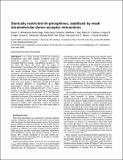Sterically restricted tin phosphines, stabilized by weak intramolecular donor-acceptor interactions
Abstract
Four related sterically restricted pen-substituted acenaphthenes have been prepared containing mixed tin phosphorus moieties in the proximal 5,6-positions (Acenap[SnR3][(PPr2)-Pr-i]; Acenap = acenaphthene-5,6-diyl; R-3 = Ph-3 (1), Ph2Cl (2), Me2Cl (3), Bu2Cl (4)). The degree of intramolecular P-Sn bonding within the series was investigated by X-ray crystallography, solution and solid-state NMR spectroscopy, and density functional theory (DFT/B3LYP/SBKJC/PCM) calculations. All members of the series adopt a conformation such that the phosphorus lone pair is located directly opposite the tin center, promoting an intramolecular donor acceptor P -> Sn type interaction. The extent of covalent bonding between Sn and P is found to be much greater in triorganotin chlorides 2-4 in comparison with the triphenyl derivative 1. Coordination of a highly electronegative chlorine atom naturally increases the Lewis acidity of the tin center, enhancing the Ip(P)-sigma*(Sn-Y) donor acceptor 3c-4e type interaction, as indicated by conspicuously short Sn-P peri distances and significant (1)J(P-31,Sn-119) spin spin coupling constants (SSCCs) in the range 740-754 Hz. Evidence supporting the presence of this interaction was also found in solid-state NMR spectra of some of the compounds which exhibit an indirect spin spin coupling on the same order of magnitude as observed in solution. DFT calculations confirm the increased covalent bonding between P and Sn in 2-4, with notable WBIs of ca. 0.35 obtained, in comparison to 0.1 in 1.
Citation
Arachchige , K S A , Camacho , P S , Ray , M J , Chalmers , B A , Knight , F R , Ashbrook , S E , Buehl , M , Kilian , P , Slawin , A M Z & Woollins , J D 2014 , ' Sterically restricted tin phosphines, stabilized by weak intramolecular donor-acceptor interactions ' , Organometallics , vol. 33 , no. 10 , pp. 2424-2433 . https://doi.org/10.1021/om500289b
Publication
Organometallics
Status
Peer reviewed
ISSN
0276-7333Type
Journal article
Description
Funding: Engineering and Physical Sciences Research Council (EPSRC)Collections
Items in the St Andrews Research Repository are protected by copyright, with all rights reserved, unless otherwise indicated.

